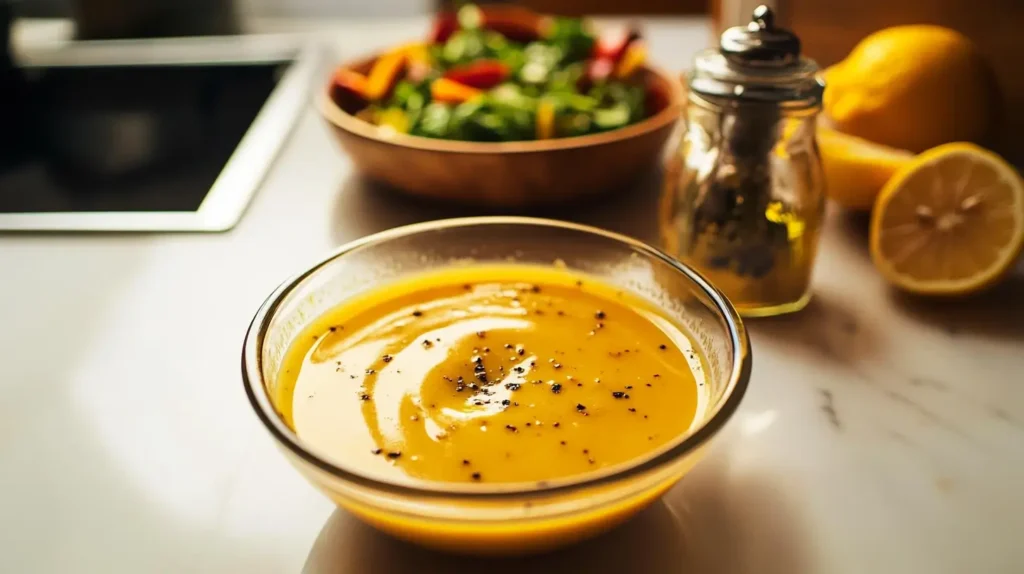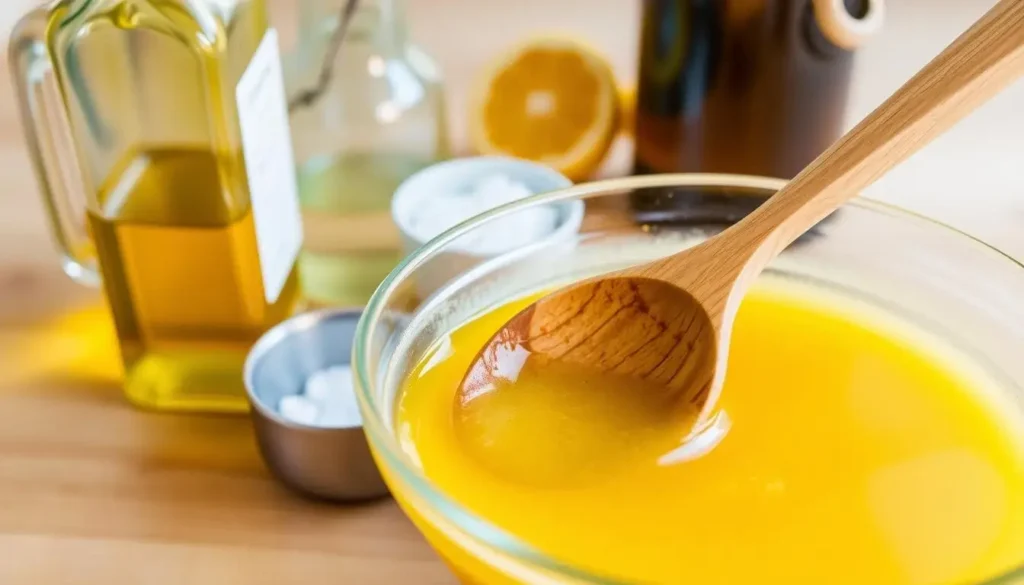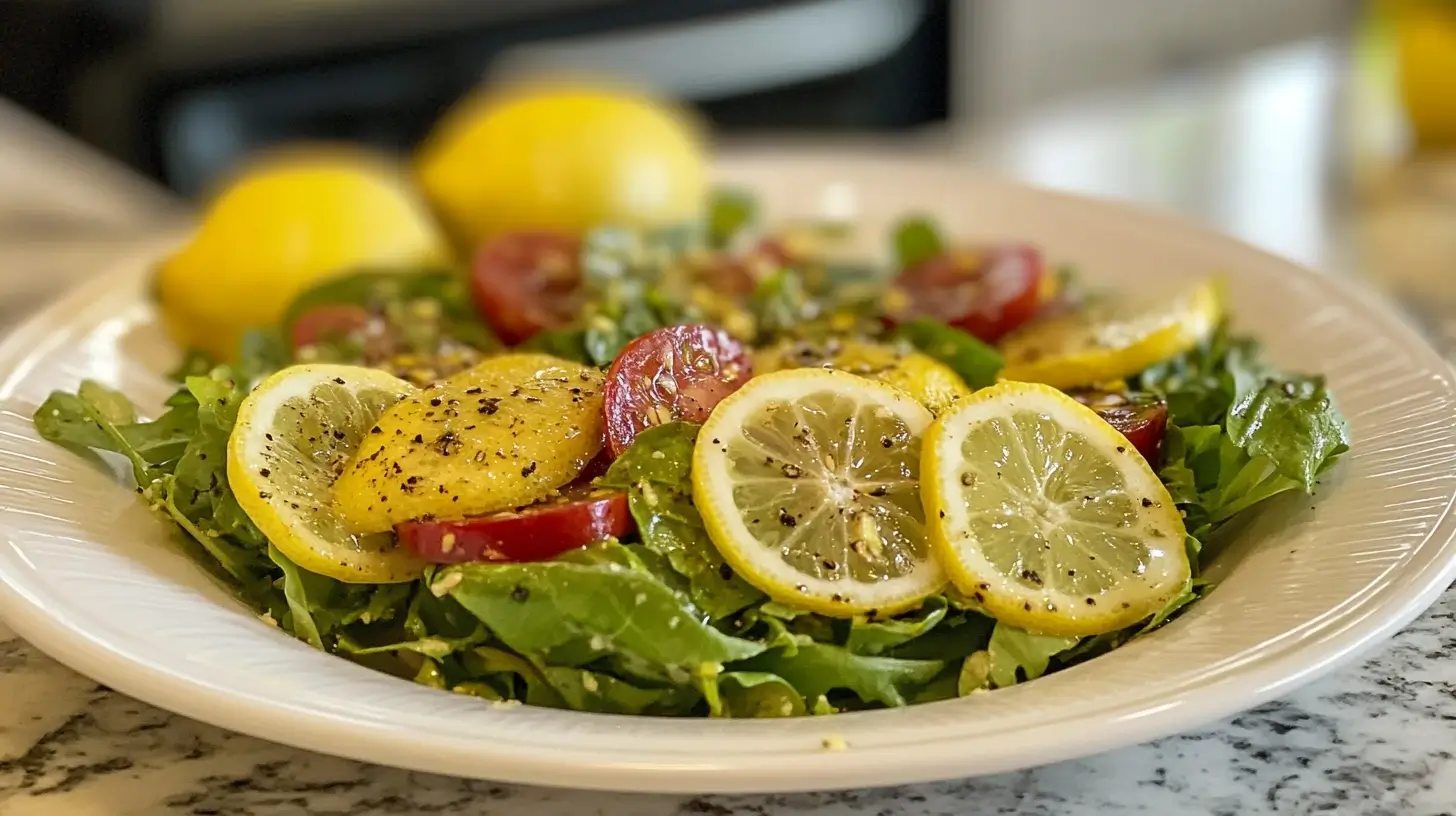The magic lies in its simplicity. Fresh lemon juice delivers a lively tang, while Dijon mustard adds depth and emulsifies the mixture perfectly. Quality olive oil creates a silky base, and a touch of garlic rounds out the flavor profile. No artificial additives – just pure, customizable taste.
What makes this recipe stand out? Its adaptability. Drizzle it over greens, roasted veggies, or protein bowls. Adjust sweetness or acidity to match your preferences. You control the ingredients, ensuring every bite aligns with your dietary needs.
Key Takeaways
- Effortless to prepare with common kitchen ingredients
- Brighter flavor than commercial dressings
- Works with salads, grains, and cooked vegetables
- Easy to customize for personal taste preferences
- Contains no preservatives or hidden additives
Introduction to Your Tangy Salad Upgrade
Ever wonder why restaurant salads taste better? The secret often lies in freshly mixed dressings. Store-bought versions can’t match the brightness of homemade blends. With a few simple ingredients, you’ll unlock flavors that transform basic greens into crave-worthy meals.

Why Freshly Made Dressings Beat Store-Bought
Commercial dressings often use stabilizers and excess sugar. Your kitchen creations skip these additives. Fresh lemon juice delivers natural acidity, while quality olive oil adds richness without heaviness. Mustard acts as a natural emulsifier, binding ingredients smoothly.
Notice the difference in texture. Homemade versions coat greens evenly instead of pooling at the bowl’s bottom. You control every element – swap honey for maple syrup, or adjust black pepper for subtle heat. It’s flavor freedom without hidden ingredients.
The Story Behind This Vibrant Recipe
This recipe grew from years of trial and error. Early attempts used bottled citrus juice, but results fell flat. Switching to freshly squeezed lemons created the zing that makes this dressing memorable. A generous spoonful of mustard became the key to creamy consistency.
The magic happens when ingredients balance perfectly. Equal parts acid and oil form the base. Herbs or spices add personality. Now you can drizzle this versatile mix over grain bowls, roasted veggies, or leafy greens with confidence.
Lemon Dijon Vinaigrette Recipe: Ingredients and Method
Transform your kitchen into a flavor lab with this foolproof formula. Every component plays a specific role in creating that signature balance between sharpness and silkiness.

Lemon Dijon Vinaigrette: A Tangy, Versatile Salad Dressing
Essential Ingredients and Their Roles
Fresh citrus juice brings vibrant acidity, cutting through rich greens. A quality olive oil forms the base, lending body and subtle fruitiness. Garlic adds aromatic depth without overpowering other elements.
The real star? Dijon mustard does double duty. Its sharpness amplifies the tangy profile while binding liquids into a smooth emulsion. No separation, just perfect cohesion.
Step-by-Step Whisking and Emulsification Process
- Combine citrus juice and mustard in a bowl
- Slowly stream in oil while whisking vigorously
- Adjust thickness by adding more oil if needed
For raw greens, use a 1:2 acid-to-oil ratio. Heartier roasted vegetables handle a 1:3 balance. Prefer shaking? A tightly sealed jar works wonders—just shake until creamy.
Too tart? Stir in ½ tsp honey. Need herbaceous notes? Fold in fresh thyme. The dressing recipe adapts to your taste buds like clay to a sculptor’s hands.
Perfecting the Emulsion: Tips and Techniques
Mastering the art of emulsion transforms good dressings into exceptional ones. This process binds oil and acid into a silky texture that clings to greens instead of separating. The key lies in understanding ratios, tools, and timing.

Balancing Acid and Olive Oil Ratios
Start with a 1:2 ratio of citrus juice to oil for delicate salads. Heartier dishes like roasted veggies handle 1:3. Use a teaspoon to measure precisely—too much acid overwhelms, while excess oil mutes brightness.
Crushed garlic enhances flavor but affects texture. For smooth results, mince it finely or infuse oil beforehand. Always add salt gradually—¼ teaspoon at a time—to avoid overpowering other elements.
Whisking Versus Shaking—Which Method Works Best?
Whisking by hand creates stable emulsions in 2-3 minutes. Pour oil slowly while mixing vigorously. For quick fixes, a tightly sealed jar works—shake for 30 seconds until creamy.
Watch for visual cues. Properly emulsified dressing coats a spoon evenly. If separation occurs, add ½ teaspoon mustard and reshake. Store leftovers in your jar for up to 5 days—flavors meld over time.
Struggling with bitterness? Roast garlic first. Too tangy? Balance with a pinch of honey. These tweaks take mere minutes but elevate every bite.
Creative Ways to Use Your Lemon Dijon Vinaigrette
Your homemade citrus-mustard blend isn’t just for leafy greens—it’s a flavor catalyst waiting to elevate everyday meals. This versatile condiment adds brightness to roasted vegetables, grains, and proteins with minimal effort.
Dressing Up Greens and Veggies
Toss roasted Brussels sprouts or carrots with 2 tbsp of the mix before baking. The acidity cuts through caramelized edges for balanced flavor. Drizzle it over quinoa bowls with chickpeas and cherry tomatoes for instant zing.
Mash ¼ avocado into the dressing for a creamy twist. It clings to kale or broccoli slaw without weighing it down. Perfect for picnics or packed lunches.
“A great dressing should adapt like a chameleon—brighten grains today, glaze proteins tomorrow.”
| Protein | Marinating Time | Flavor Boost |
|---|---|---|
| Chicken breasts | 30 mins | +1 tsp smoked paprika |
| Tofu slabs | 20 mins | +½ tsp sesame oil |
| Shrimp skewers | 15 mins | +1 minced garlic clove |
Marinade Mastery
Brush the blend onto salmon fillets 10 mins before grilling. The citrus tenderizes while the mustard creates a golden crust. For lentils or beans, stir in 1 tbsp to replace bland oil-and-vinegar mixes.
Need a quick upgrade? Toss warm pasta with the dressing, sun-dried tomatoes, and Parmesan. The heat helps the flavors cling to every noodle.
Customizing Your Dressing for Personalized Flavor
Unlock endless possibilities by tailoring your vinaigrette dressing to match any meal. A few tweaks transform the base recipe into your signature creation. Let’s explore how to adjust sweetness, texture, and herbal notes.
Flavor Variations: Sweeteners, Herbs, and Spices
Swap sweeteners to suit your palate. Maple syrup adds earthy notes, while monk fruit keeps it sugar-free. For herbal flair, mix in ½ tsp dried thyme or fresh basil. Spice lovers can shake in chili flakes or smoked paprika.
Balancing salt pepper ratios matters. Start with ¼ tsp each, then taste. Too sharp? Add ½ tsp honey. Too mild? Double the cracked pepper. These small changes take minutes but make big differences.
Adjusting Consistency and Storage Tips
Prefer a thicker dressing? Reduce olive oil by 1 tbsp. For lighter texture, add 2 tsp water. Always whisk in a small bowl first to test adjustments before scaling up.
| Add-In | Flavor Impact | Best Paired With |
|---|---|---|
| Maple syrup | Earthy sweetness | Kale salads |
| Fresh dill | Bright herbal kick | Grilled fish |
| Roasted garlic | Mellow depth | Roasted veggies |
Store leftovers in a sealed jar for 5-7 days. Shake for 30 seconds before each use. For single servings, mix in a small bowl with 1 tsp less oil. The dijon quantity controls creaminess—add ½ tsp more for richer texture.
Conclusion
Elevate everyday meals with a homemade blend that marries simplicity with gourmet flair. This citrus-mustard mix delivers freshness store-bought dressings can’t match, while saving you money and kitchen time. Whip it up in minutes using quality olive oil, fresh citrus, and aromatic spices—no added sugar or preservatives.
Use it beyond salads. Drizzle over roasted vegetables, toss with grains, or marinate proteins. Store leftovers in your fridge for up to a week—the flavors deepen over time. Swap maple syrup for honey if you prefer earthy sweetness, or add herbs for complexity.
Your kitchen becomes a flavor playground. Adjust thickness by tweaking oil ratios, or brighten sauces with extra lemon. Share your creations online to inspire others. With this versatile base, every meal gets a vibrant upgrade.
Pickled Cheese: Discover the Delicious World
FAQ
Can I use bottled lemon juice instead of fresh?
Freshly squeezed citrus juice provides brighter flavor, but bottled works in a pinch. Reduce the quantity slightly, as bottled versions often taste more concentrated.
How long does this dressing stay fresh?
Store it in an airtight container in the fridge for up to 7 days. Shake or whisk before using, as separation is natural.
What if my emulsion breaks?
Slowly whisk in 1 teaspoon of honey or maple syrup to rebind the mixture. Alternatively, add a small amount of water while whisking vigorously.
Can this recipe work as a marinade?
Absolutely! The acidity tenderizes proteins, while olive oil keeps them moist. Marinate chicken, fish, or tofu for 30 minutes to 2 hours before cooking.
How do I make it less tangy?
Balance sharpness with ½ teaspoon of honey or agave nectar. Alternatively, increase olive oil by 1 tablespoon to mellow the flavor.
Can I substitute whole-grain mustard?
Yes, but texture will vary. For smoother consistency, stick with classic Dijon. Whole-grain adds rustic appeal but may require extra whisking.
Is this dressing gluten-free?
When using pure mustard and verified gluten-free ingredients, it’s suitable for gluten-free diets. Always check labels for hidden additives.
Can I add fresh herbs?
Chopped thyme, basil, or dill elevate freshness. Add herbs just before serving, as prolonged storage may cause bitterness.

